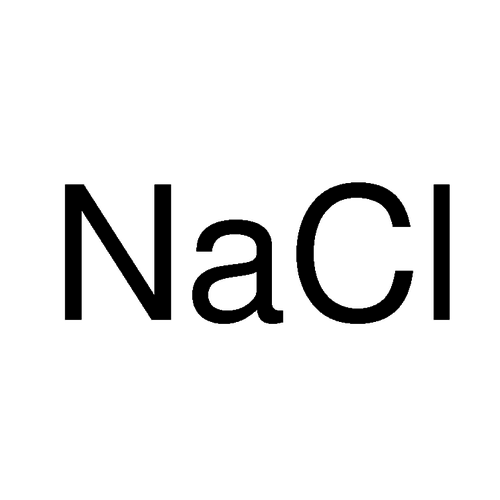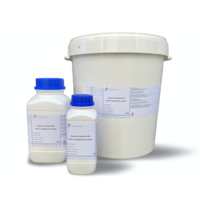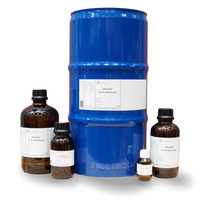You have no items in your shopping cart
Sodium Chloride 99.9+% Ph. Eur, FCC
- Buy 2 and save 5%
- Buy 6 and save 10%
This sodium chloride is very pure and of pharmaceutical quality (ph. eur) and contains no anti-caking agent or other additives
What is Sodium Chloride?
Sodium chloride is the sodium salt of hydrochloric acid with the chemical formula NaCl - not to be confused with sodium chlorite (NaClO2), the sodium salt of chloric acid.
Sodium chloride is the most important mineral for humans and animals. An adult human body contains about 150-300 g of Sodium Chloride and loses 3-20 g every day, which must be replaced. It was mined for this purpose in prehistoric times and remained a precious commodity for a long time.
What is Sodium Chloride used for?
-Sprinkling salt
Rock salt is used in winter at moderate freezing temperatures as de-icing salt (road salt), sometimes with additives to maintain fluidity. In Germany, road salt was colored to prevent its use in food preparation. However, with the abolition of the salt tax on January 1, 1993, it has become obsolete. Brine is also added before spreading to produce more suitable moist salt.
-Industrial salt
Virtually all commercially, technically or industrially used salt that does not fall into any of the other three categories is referred to as industrial salt. Salt for preserving food counts as industrial salt, although it is consumed in small quantities. The spectrum of industrial salt is therefore very large and varies from coarse, raw rock salt to high-purity sodium chloride and sterile preparations for chemical, pharmaceutical and medical purposes. A wide variety of additives are also added depending on the use.
-Livestock farming
Cattle salt is added to the feed of farm animals such as cattle, sheep and goats (unpurified, denatured rock salt, possibly with other mineral salts as additives). This increases their appetite and contributes to overall health.
Salt licks are also known, which are used in zoos, in livestock farming, in domestic and companion animals and for wild animals.
-Conservation
Salt is traditionally used for preserving foodstuffs such as meat, fish (such as salted herring), vegetables (sauerkraut), etc. Due to the osmotic effect of the salt, the moisture is removed from the home. This removes the base of water for harmful organisms, but also kills germs and pathogens.
Nitrite hardening salt consists of a mixture of table salt and sodium nitrate, sodium nitrite or potassium nitrate.
By soaking vegetables (such as pickled cucumbers, olives) in brine, the germicidal effect is used.
Cheese is prepared in salted water before it ripens and pickled with brine during the ripening process to keep the rind dry.
-Physical/chemical applications
Salt is used as a regeneration salt to soften water in dishwashers and water treatment systems. In cold mixtures, it is mixed with water.
Salt is also an indispensable raw material when processing and dyeing leather.
In the manufacture of bowls and other ceramics, the traditional salt glaze is created by adding moist salt at a high temperature. The sodium ion from the table salt dissociated in the oven atmosphere combines with the clay's silicates to form a permanent glaze. However, the salt is aggressive at the application temperatures (1,200 °C and above) and damages the interior of the oven (the heat insulation on the fire side), which therefore needs to be replaced more often.
The ionizing effect of the salt is used in metal processing.
-medicine
In modern medicine, a 0.9% solution of sodium chloride in water is used as a carrier solution for medicines.
In ancient times and in the Middle Ages, salt-based medicines were considered effective remedies. The skin of newborns was rubbed with salt to strengthen them. It was used in wound dressings, plasters, ointments, powders and baths. Particular importance was given to the drying and warming effects of the salt.
In the Middle Ages, salt was also used for the external treatment of ulcers and wounds, as it was considered astringent, cleansing and soothing.
Salt was sprinkled into wounds to prevent inflammation - a sometimes very painful procedure that has found its way into the German language in a corresponding phrase ("sprinkle salt into open wounds"). Pure salt destroys all cells via osmosis - including pathogenic microorganisms such as bacteria and fungi, but also the cells of the injured. This form of disinfection is therefore double-edged, as is the burning of wounds. The same mechanism of action prevented foods preserved in table salt from spoiling, i.e. being broken down by microorganisms.
Brine baths are still used as a remedy. Spa resides by the sea or in salty air near salt pans and formerly in salt mines to treat respiratory ailments. Where this is not possible or too expensive, inhalers in which salt aerosol is inhaled are used.
Saline solution is also used for nasal irrigation and gargling. An isotonic saline solution is used for rinsing the nose, because normal water would cause the mucous membranes to swell due to osmosis.
-Infrared optics
Crystalline sodium chloride is sufficiently transparent to allow light with wavelengths between 0.21 and 25 µm to be used for optical elements. Lenses, prisms and windows suitable for both the visible range and the near to mid-infrared are therefore made of sodium chloride. Due to the water solubility of sodium chloride, optical elements of this material are damaged by moisture. However, this can be avoided if their temperature is kept above the ambient temperature. For this reason, heaters are often integrated into the brackets used. Sodium chloride windows are commonly used as Brewster windows for high power, pulsed CO2 lasers, as well as in other areas. In infrared spectroscopy, it is pressed into tablets as a carrier for test samples.
-Chemical analysis
According to the Pharmacopoeia, sodium chloride is the primary substance used to adjust silver nitrate standard solutions. To make a sodium chloride standard solution, it must first be dried.
Buy sodium chloride at Laboratoriumdiscounter.nl
The best quality sodium chloride does not have to be expensive. At Laboratory Discounter we have this sodium chloride that is of both pharmaceutical and food grade quality. Because we sell this under our house brand and buy in bulk, we can offer this competitively. So buy your sodium chloride at Laboratoriumdiscounter. Always in stock and delivered quickly!
Technical data:
Empirical formula NaCl
Molar mass (M) 58,44 g/mol
Density (D) 2,17
Boiling point (bp) 1461 °C
Melting point (mp)801 °C
Solubility 358 g/l (H2O, 20 °C)
WGK 1
CAS No.[7647-14-5]
EG-Nr. 231-598-3
Downloads











